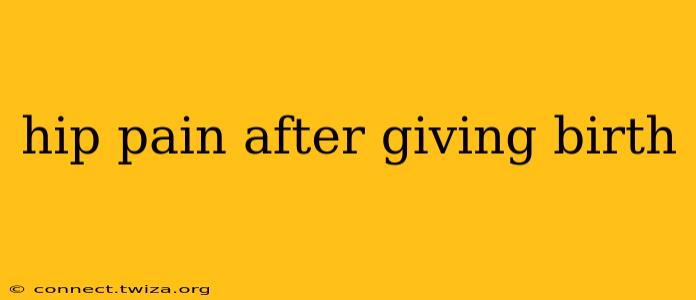Congratulations on your new arrival! The joy of childbirth is often overshadowed by the physical challenges that follow, and hip pain is a common complaint among postpartum women. This comprehensive guide explores the various causes of hip pain after giving birth, effective treatment options, and preventative measures to help you regain comfort and mobility.
What Causes Hip Pain After Childbirth?
Several factors can contribute to hip pain following delivery. Understanding these causes is the first step towards effective management.
Hormonal Changes
Pregnancy triggers significant hormonal shifts, particularly in relaxin production. Relaxin softens ligaments and joints, preparing the body for childbirth. While beneficial for delivery, this increased laxity can also destabilize the pelvic joints, leading to pain in the hips and surrounding areas. This effect can linger for several weeks or even months postpartum.
Weight Gain
The weight gained during pregnancy puts additional stress on the hips and joints. This extra weight, combined with the hormonal changes, can exacerbate existing hip problems or create new ones. Losing weight gradually after delivery can help alleviate this pressure.
Posture Changes
Pregnancy alters a woman's center of gravity, leading to postural changes that strain the hips and lower back. Carrying a baby further contributes to this strain, potentially causing or worsening hip discomfort. Maintaining good posture and using supportive aids like a baby carrier can help mitigate this.
Muscle Weakness
The muscles supporting the hips and pelvis can weaken during pregnancy and childbirth. This weakness can lead to instability and pain. Targeted exercises can strengthen these muscles and improve support.
Pelvic Instability
This refers to the loosening of the ligaments and joints in the pelvis, often causing a feeling of instability or giving way in the hips. This is directly related to the hormonal changes mentioned above.
Previous Injuries or Conditions
Pre-existing hip conditions such as osteoarthritis or labral tears can be aggravated by the physical stresses of pregnancy and childbirth.
Symphysis Pubis Dysfunction (SPD)
SPD is a condition causing pain in the pubic symphysis, the joint connecting the two pubic bones. This pain often radiates to the hips and groin.
Sacroiliac Joint Dysfunction (SIJD)
SIJD involves pain in the sacroiliac joints, where the sacrum (the triangular bone at the base of the spine) connects to the pelvis. This pain can also manifest as hip pain.
How is Hip Pain After Childbirth Treated?
Treatment options depend on the underlying cause and severity of the pain.
Rest and Ice
Initially, rest and applying ice packs to the affected area can help reduce inflammation and pain.
Physical Therapy
Physical therapy plays a crucial role in strengthening weakened muscles, improving joint stability, and restoring proper posture. A physical therapist can create a personalized exercise program tailored to your specific needs.
Medications
Over-the-counter pain relievers like ibuprofen or acetaminophen can help manage pain. In some cases, a doctor may prescribe stronger pain medication or muscle relaxants.
Pelvic Belts or Supports
These supportive garments can provide stability to the pelvic region and alleviate some discomfort.
Manual Therapy
Techniques like chiropractic care or osteopathy can address joint misalignments and improve mobility.
Can Hip Pain After Childbirth Be Prevented?
While not all cases of postpartum hip pain are preventable, certain steps can significantly reduce your risk.
Maintain a Healthy Weight
Managing weight gain during pregnancy can lessen the stress on your hips and joints.
Engage in Regular Exercise
Prior to and during pregnancy (with your doctor's approval), engaging in safe exercises that strengthen core muscles and pelvic floor muscles can help prevent instability. Postpartum, gradually reintroduce exercise, focusing on gentle movements.
Maintain Good Posture
Consciously maintaining good posture throughout pregnancy and postpartum can minimize strain on your hips.
Seek Professional Help Early
If you experience hip pain, don't hesitate to consult your doctor or a physical therapist. Early intervention can often prevent the condition from worsening.
Frequently Asked Questions (FAQs)
How long does hip pain after childbirth last?
The duration of hip pain varies greatly, ranging from a few weeks to several months, depending on the cause and severity. In some cases, it can persist longer.
What exercises can help with hip pain after childbirth?
Gentle exercises focusing on core strengthening, pelvic floor exercises (Kegels), and hip stretches are generally recommended. Consult a physical therapist for a personalized exercise plan.
When should I see a doctor about hip pain after childbirth?
Seek medical attention if your pain is severe, persistent, doesn't improve with rest and self-care, or is accompanied by other symptoms like numbness, tingling, or weakness.
Remember, postpartum recovery is a process, and seeking professional help is crucial for addressing hip pain effectively and regaining your comfort and mobility. Be patient with yourself and celebrate the progress you make along the way.
